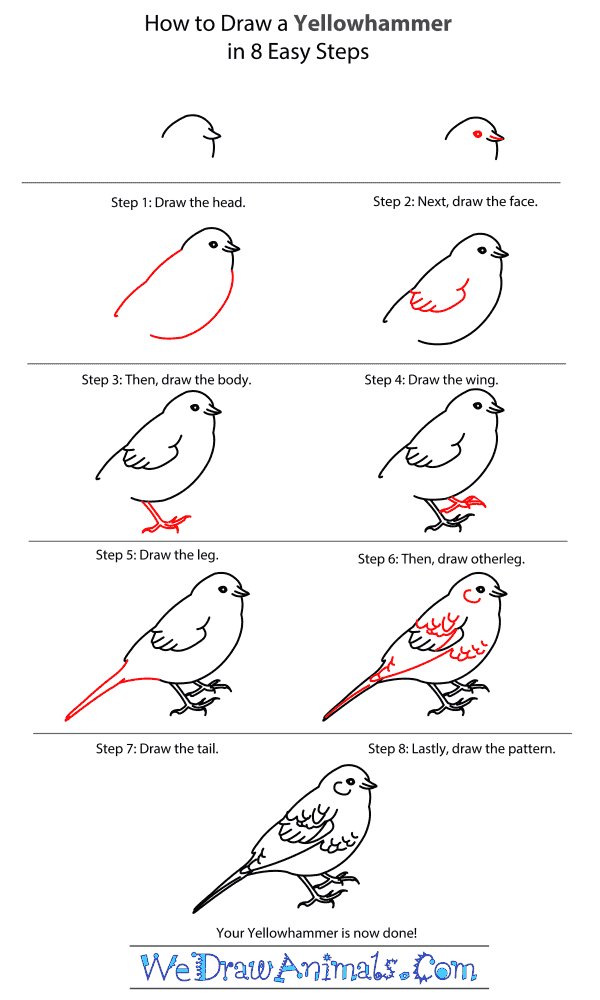In this quick tutorial you'll learn how to draw a Yellowhammer in 8 easy steps - great for kids and novice artists.
The images above represent how your finished drawing is going to look and the steps involved.
Below are the individual steps - you can click on each one for a High Resolution printable PDF version.
At the bottom you can read some interesting facts about the Yellowhammer.
Make sure you also check out any of the hundreds of drawing tutorials grouped by category.
How to Draw a Yellowhammer - Step-by-Step Tutorial
Step 1: Start by drawing the head. It is a crooked upside down wide "U" shape. Along the top left side of the head draw a sharp pointy beak.
Step 2: Draw a short line in the beak to make the mouth. At the end of that line draw a round eye.
Step 3: From the left line of the head draw a straight line angled down and to the left. Continue the right side of the head line down and curve it back around to the left towards the back line.
Step 4: About halfway up the back line draw a curvy line to make the wing. There are four small bumps to make the feathers.
Step 5: At the very bottom of the belly line draw two straight lines down to make the leg lines. The leg is skinny. There are four long pointy toes at the bottom of the leg. Three toes point to the right and the fourth toe points to the left.
Step 6: Just to the right of the first leg draw another leg. It will be much shorter than the first leg. There are also three pointy toes on the right side of the leg and a fourth pointing to the left.
Step 7: Between the back line and the belly line draw two lines together gradually to make the tail. Make the tip pointy.
Step 8: Lastly, draw the feather patterns along the tail and wings. The tail simply has a straight line. There are curvy "W"s along the wings and the belly.
Interesting Facts about the YELLOWHAMMER
The Yellowhammer is a member of the bird group and the scientific term for them is Emberiza citrinella. Their name is derived from the golden color that they have. They also have black stripes on their back. This animal is related to the Bunting type of bird because they are a passerine (3 toes forward, one toe backward) breed from Europe, Asia, and Africa, from the Emberizidae family. The German word Emberiza means “Bunting” and the Italian word citrinella means “small yellow bird.” The English name “hammer” is derived from a German synonym for “Bunting.” Another common name for this animal is the Scribble Lark, because their eggs appear to have lots of writing on them, and therefore the parent seems to enjoy doing it (larking). Legend indicates that these are messages from the Devil.
Did you know?
- This animal was first documented in 1758.
- The length is up to over .5 feet long.
- Their wingspan is almost 1 feet wide.
- This species inspired Beethoven’s 4th Piano Concerto.
- This species inspired Beethoven’s 5th symphony.
- This species inspired Beethoven’s No. 21 in C major.
- This species inspired Beethoven’s No. 23 in F minor.
This species is found in Europe and Asia. They have a unique song that sounds like they are saying “A little bit of bread and no cheese.” These animals have a low population amount, but are considered to be the least concern for the possibility of extinction.









